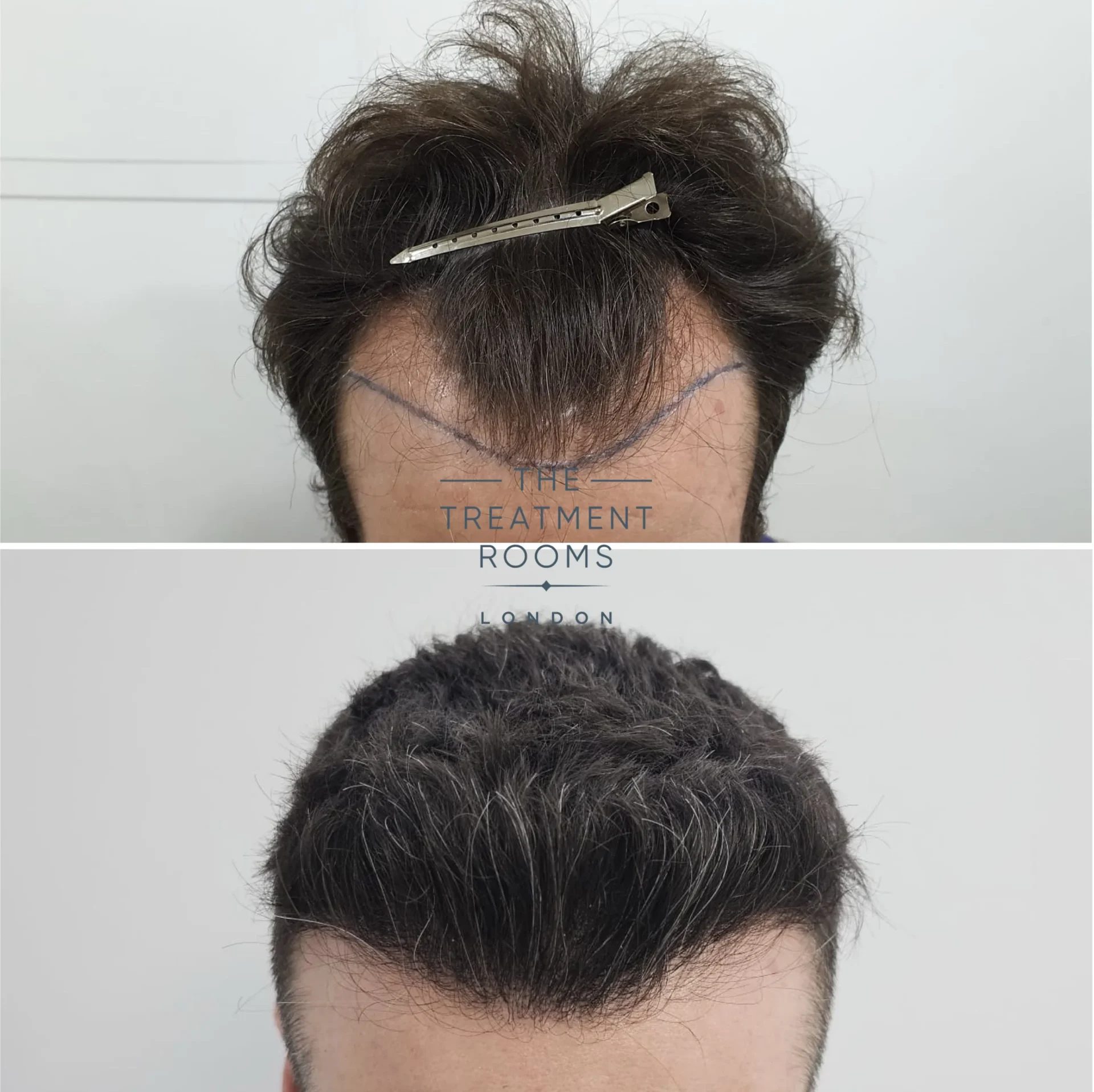Women can develop a widow’s peak at some point in life, either due to it being their natural hairline or hair loss in the form of female pattern baldness or traction alopecia1. Hair transplant surgery can be a useful treatment to reduce the appearance of a widow’s peak in women. This article will explore how.
What is a Widow’s Peak in Women?
A widow’s peak in women is a hairline shape where the hairline forms a point centred on the forehead. It’s characterised by a “V” or “M” shape. In some women, the hairline forms a straight, oval line across their forehead. However, in some individuals, hair growth is higher on either side in the temples. This causes a “peak” in the hairline at the centre.
The widow’s peak is often confused with a receding hairline. A widow’s peak is something you’re born with, whereas a receding hairline occurs over time due to age, stress, female pattern baldness or traction alopecia.

In women, the widow’s peak isn’t immediately obvious. It’s more obvious if you pull your hair back, tracing your finger along the hairline where in the centre it dips in a “V” or “M” shape.

Why Is It Called a Widow’s Peak?
The term “widow’s peak” comes from 18th-century England2. Back then, it was tradition that when the husband died, his wife would wear a black triangular hood or hat with a peak or bill falling down the centre of the forehead. Because the hairline resembles the beak of the hood, the name stuck.
Reverse widow’s peak
There is another type of hairline termed a ‘reverse widow’s peak’. As you might expect, this pattern is the exact opposite of a widow’s peak, with a ‘V’ shape going in the opposite direction.
While a reverse widow’s peak may occur due to a receding hairline in men, the pattern is also associated with frontal fibrosing alopecia, an autoimmune condition which often affects women.
Female Widow’s Peak Causes
Inheriting a Widow’s Peak as a woman
A widow’s peak in a female is often seen also in their parents, grandparents, or siblings. However, that’s not always the case, and we aren’t clear on how a widow’s peak in women is inherited. For most people, a widow’s peak is a common natural variant.
Female widow’s peak Associated with Hair Loss
It should be noted that a widow’s peak in women can be associated with a receding hairline. Less common than in men, it can also occur due to severe stress, malnutrition, and menopause.
You can also develop a widow’s peak by repetitively tying your hair tightly, causing traction alopecia at the front of the hairline. This causes tension on the hair follicles, which over time causes them to weaken and fall out. This is summarised in the diagram below.
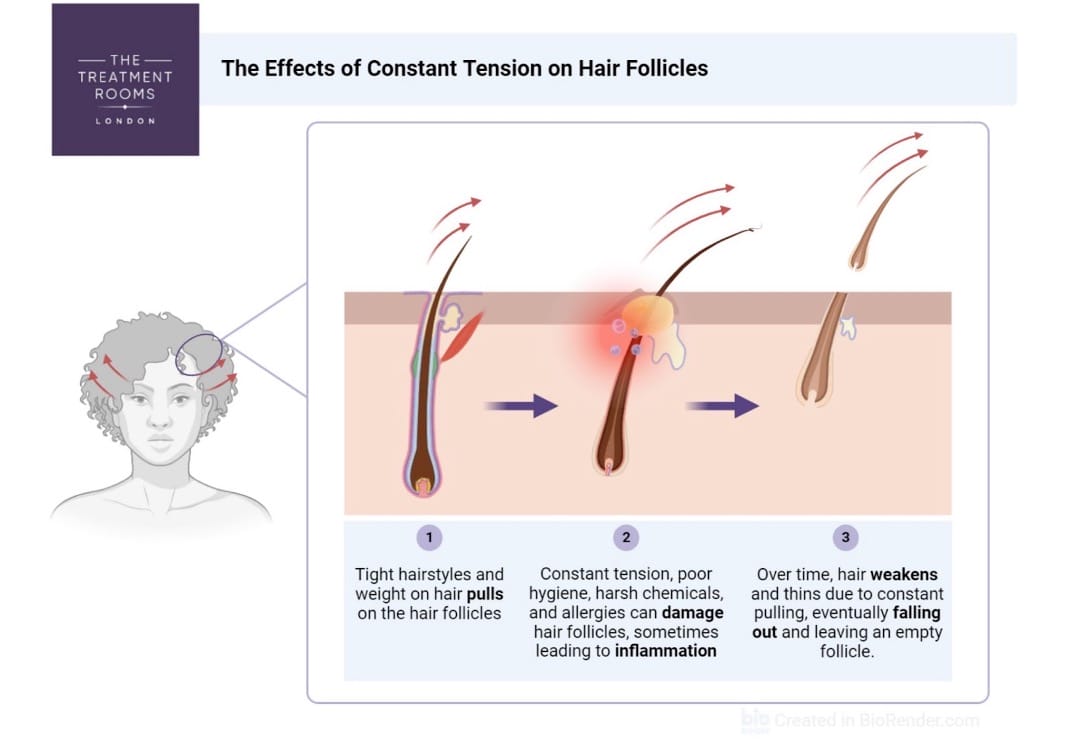
Genetic causes for a widow’s peak in women
In rare cases, it’s the sign of an underlying genetic condition such as Donnai-Barrow Syndrome, Frontonasal Dysplasia and Opitz G/BBB syndrome.
Female Widow’s Peak Treatment
The widow’s peak is a surprisingly common hairline. Some notable examples include Grace Kelly, Marilyn Monroe, Blake Lively, and Britney Spears.
While some people embrace their hairline, others do not find it an attractive feature. You may wish for it to be removed or minimised. Certain hairstyles, such as growing a fringe, will make it less apparent. However, if you like to wear your hair back or in a ponytail, it can expose your widow’s peak.
Potential options to change or flatten a widow’s peak in women include:
- Shaving. Trimming the widow’s peak using a razor is one solution. This is possible for a minor widow’s peak but is not viable if it is more prominent. Your hair will also grow back, leaving a patch of stubble.
- Waxing and/or Sugaring. This works similarly to shaving but achieves a longer-lasting result. You will see a patch of stubble within a few weeks, and the procedure must be continually repeated.
- Depilatory Creams. These creams cause your hair to fall out. They’re often hard to apply solely to the widow’s peak and can cause irritation or burns.
- Laser Hair Removal or Electrolysis. This is a permanent solution to remove a widow’s peak. However, it can take several sessions to achieve a lasting result.
An alternative option is a female window’s peak hair transplant. It involves straightening the hairline by adding new hairs to lower the hairline to create a more uniform, feminine appearance.
Female Widow’s Peak Hair Transplant
A female’s widow’s peak hair transplant involves adding hair follicles to the hairline to create a straighter appearance. This can either eliminate the widow’s peak completely or minimise its appearance.
There are two potential mechanisms:
- Follicular unit excision (FUE) involves removing the individual hair follicles from the back or sides of the scalp. The follicles are excised using a hole punch technique. These follicles are then inserted in the hairline to create a more uniform look.
- Follicular unit transplantation (FUT) removes a thin strip of skin from the back of the scalp. The hair follicles are then extracted and transplanted into the hairline. FUT requires less shaving for women.
FUE minimises scarring and is the preferred option for mild widow’s peaks in women. However, in women with a strong deep deep-looking widow’s peak, an FUT hair transplant may be required. The procedure involves more hair follicles, allowing your surgeon to achieve a denser final appearance. In both procedures, hairs are inserted individually, allowing your Surgeon to control the direction and density of follicles, achieving a natural look.
Widow’s peak vs receding hairline
Like a widow’s peak, a receding hairline is a pattern of hair loss that is very common. A receding hairline can develop at any age, but tends to affect men in their thirties and older.
Both a widow’s peak and a receding hairline (caused by male pattern baldness) can be hereditary and develop over time. The key takeaway here is that while a widow’s peak refers specifically to the ‘V’ shape pattern that people are born, and age with.
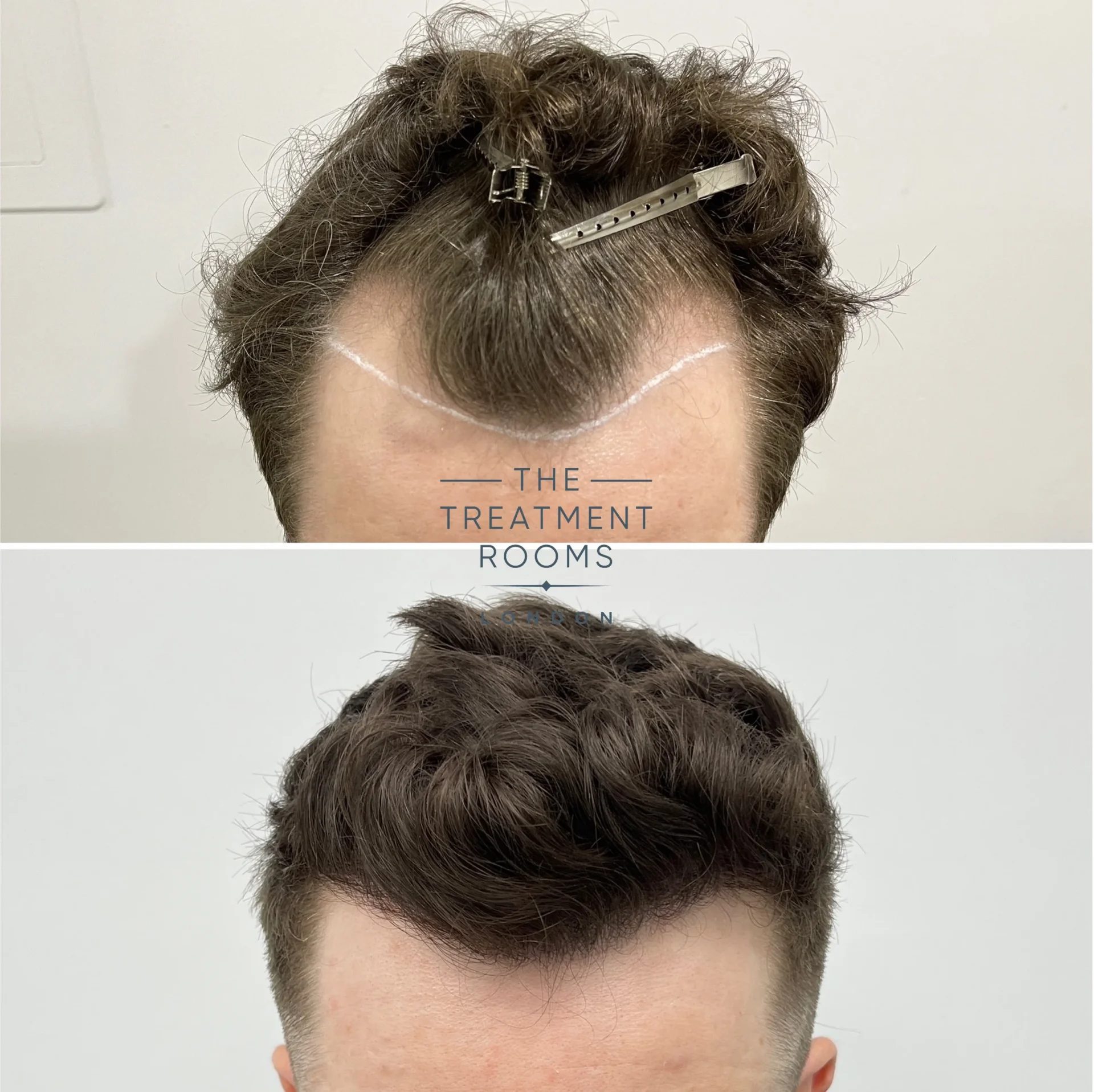
If you have always had a widow’s peak, it doesn’t mean you will develop a receding hairline. You may be born with a widow’s peak that doesn’t recede significantly.
The main differences between a widow’s peak and a receding hairline are summarised below.
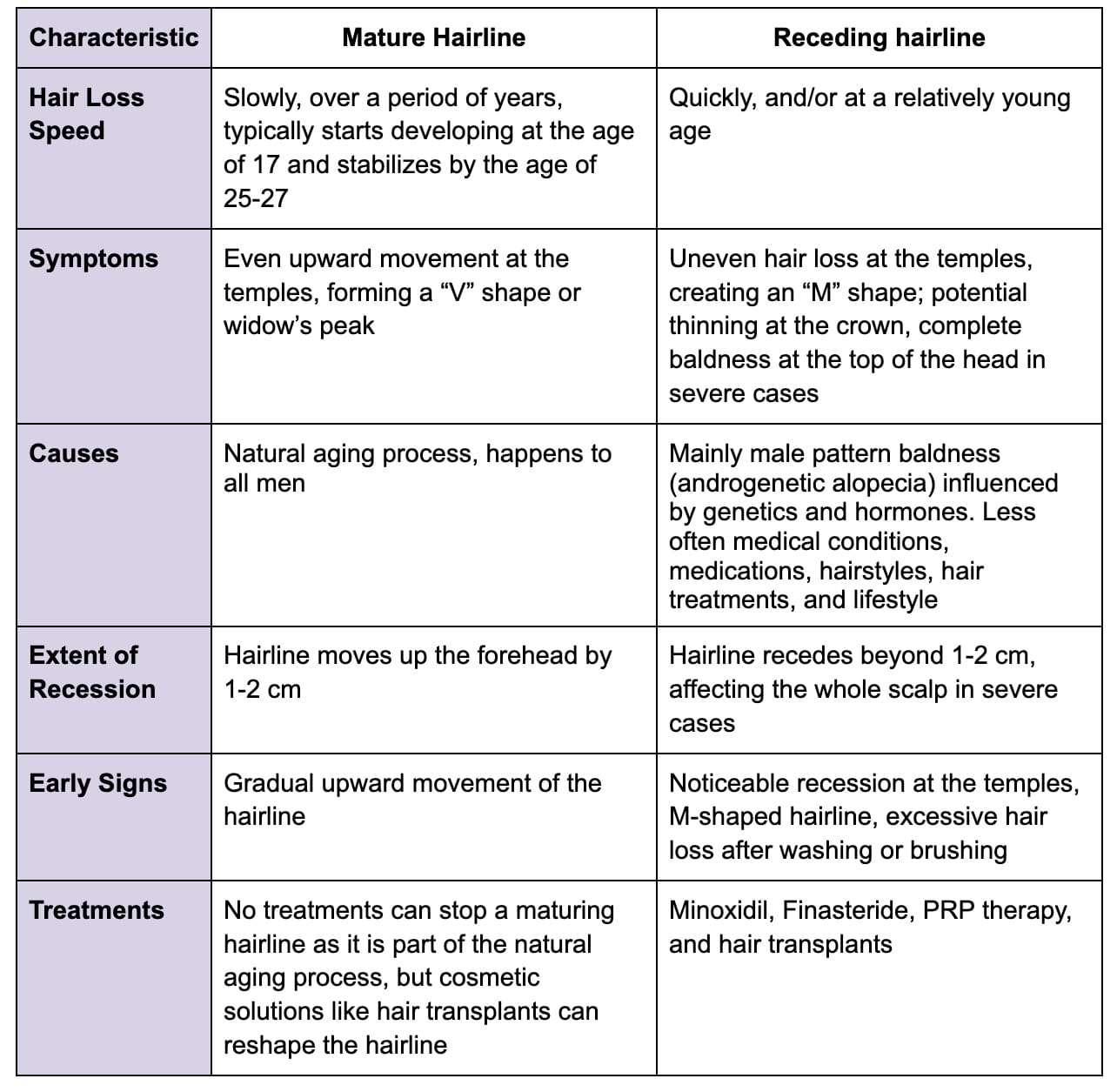
A receding hairline is more of an umbrella term that can also refer to thinning and balding at the temples caused by an underlying condition like male pattern baldness, which can also lead to a “V” shaped hairline that mimics a widow’s peak. You can see an example of this below.
How to get rid of a widow’s peak
There are various ways that you can treat a widow’s peak. These include:
- Changing hairstyle: your barber or hairdresser can recommend a hairstyle that makes a widow’s peak less noticeable and improves your appearance
- Use hair removal creams: you can buy creams (depilatories) that remove hair and will slow regrowth compared to shaving
- Waxing: You can remove hair by applying a layer of hard wax and removing it
- Electrolysis: a technique that uses heat to remove individual hairs and prevent regrowth
- Laser removal: using strong light beams to destroy the hair follicles. This method can stop hairs from growing back more effectively than most of the above methods
- Hair transplant: A hair transplant can correct a widow’s peak, and we’ll discuss this option in more detail in the next section
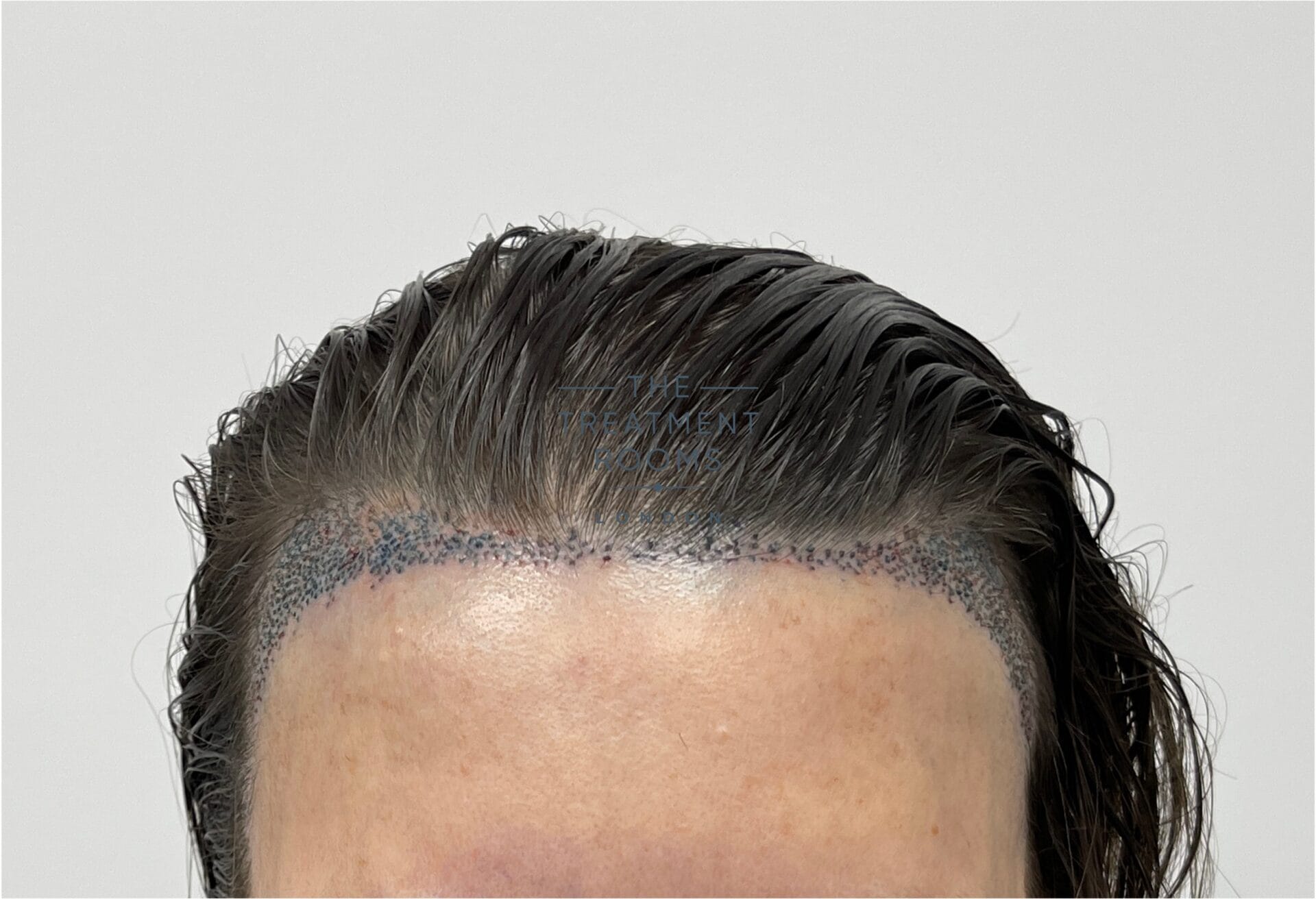
Cost For A Widow’s Peak Hair Transplant
A widow’s peak transplant can cost between £3,000 to £8,000, with the price dependent on how many grafts you require for your transplant and whether you opt for an unshaven or shaven hair transplant.
Widow’s peak hair transplant graft number and cost
If you have lost a minimal amount of hair either side of your widow’s peak, you will require less hair to be transplanted. This will mean the overall cost of your widow’s hair transplant is lower. Generally hair transplant surgery for a widow’s peak can be categorised as small, medium or large in size.
Small widow’s peak hair transplant cost
Such cases can be seen here: small widow’s peak hair transplants 500-900 grafts. The price for such surgery can range between £3,000- £4,500 and an example can be seen below.
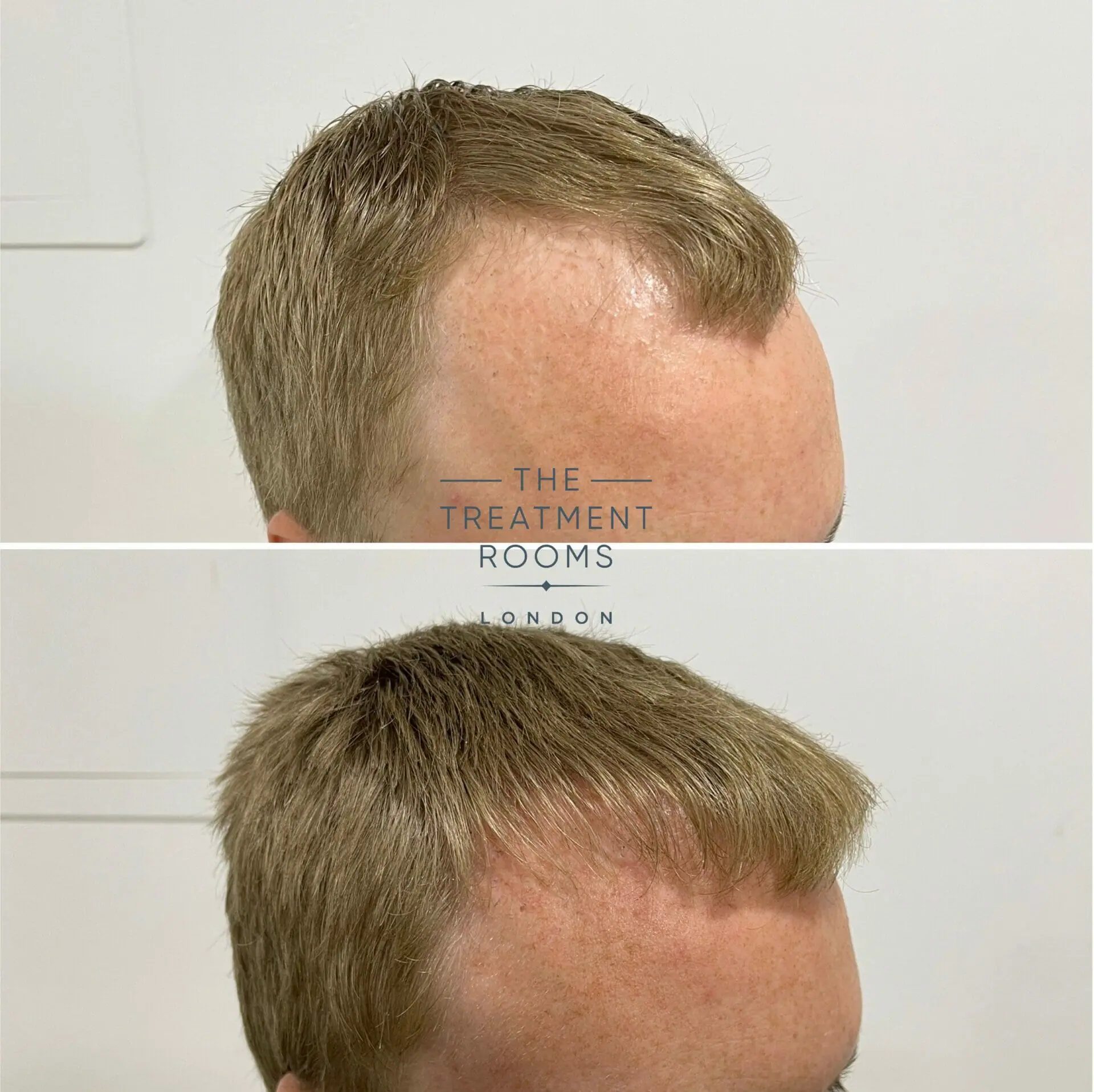
Medium widow’s peak hair transplant cost
You may have lost a moderate amount in your temples creating a deeper widow’s peak. This might require 900-1400 grafts to transplant into to soften the widow’s peak appearance. As a result the cost for a medium sized widow’s peak hair transplant will range between £4,000- £5,500.
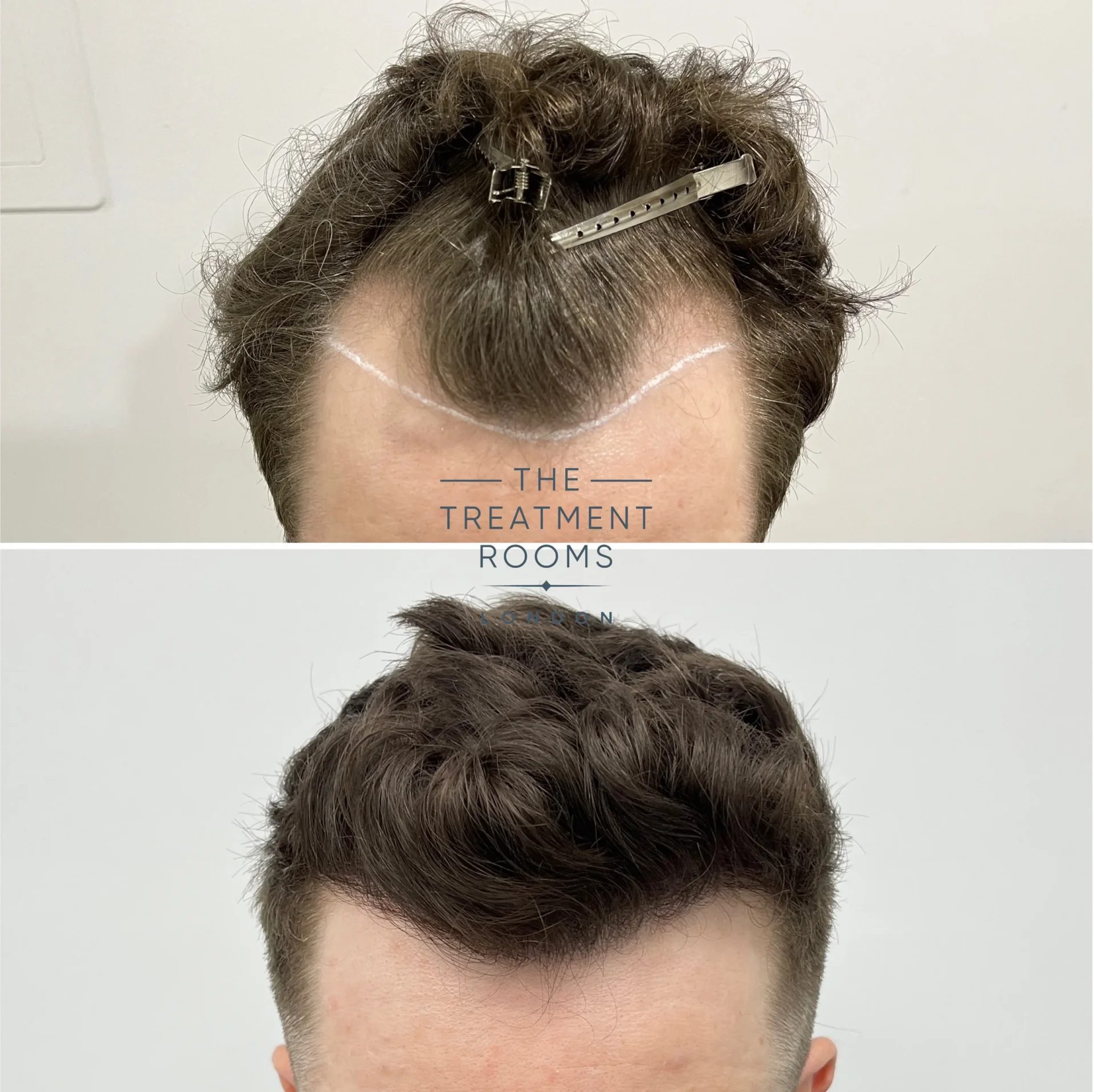
Large widow’s peak hair transplant cost
The more hair you have lost in your temples, the larger a surgery you may require for your widow’s peak. As a result, the cost for a large-sized widow’s peak hair transplant will be higher. Such cases can be found here: widow’s peak hair transplants, 1400-1800 grafts. The price for such surgery can range between £5,000- £8,000.
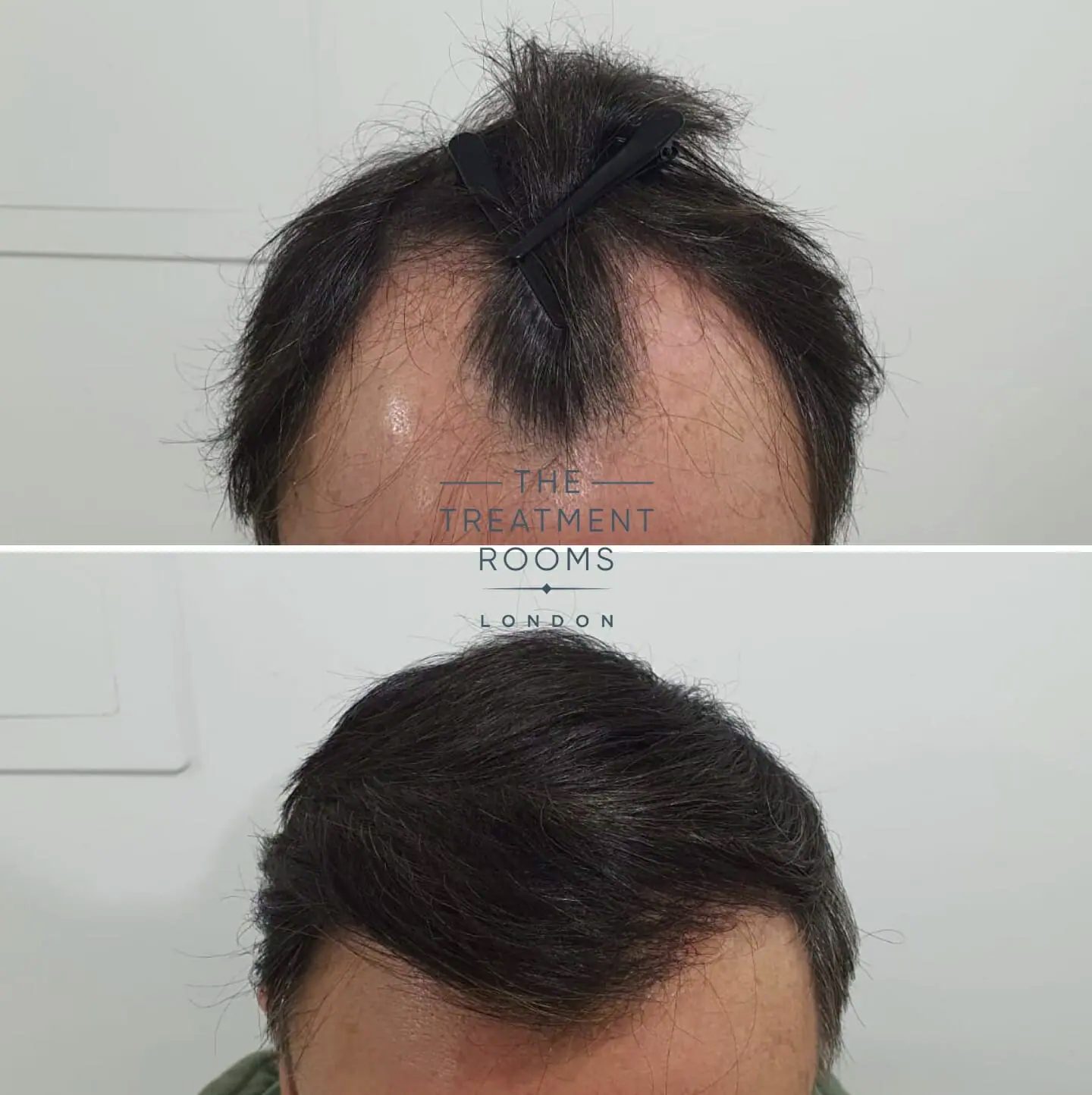
Unshaven widow’s peak hair transplant cost
Some patients choose to undergo an unshaven hair transplant, as only the 2 temples either side of the widow’s peak, will need to be shaved as well as the donor area. This will allow the rest of your hair in the widow’s peak and behind to cover the temples and the areas that have been operated on. This can enable patients to return to work and social commitments quicker.
Choosing to have an unshaven widow’s peak hair transplant will cost more, as the surgery will take more time and diligence by your Surgeon. As a result, you can expect an unshaven widow’s peak hair transplant to cost more than a regular shaven widow’s peak hair transplant. An example of an unshaven widow’s peak hair transplant is shown below.
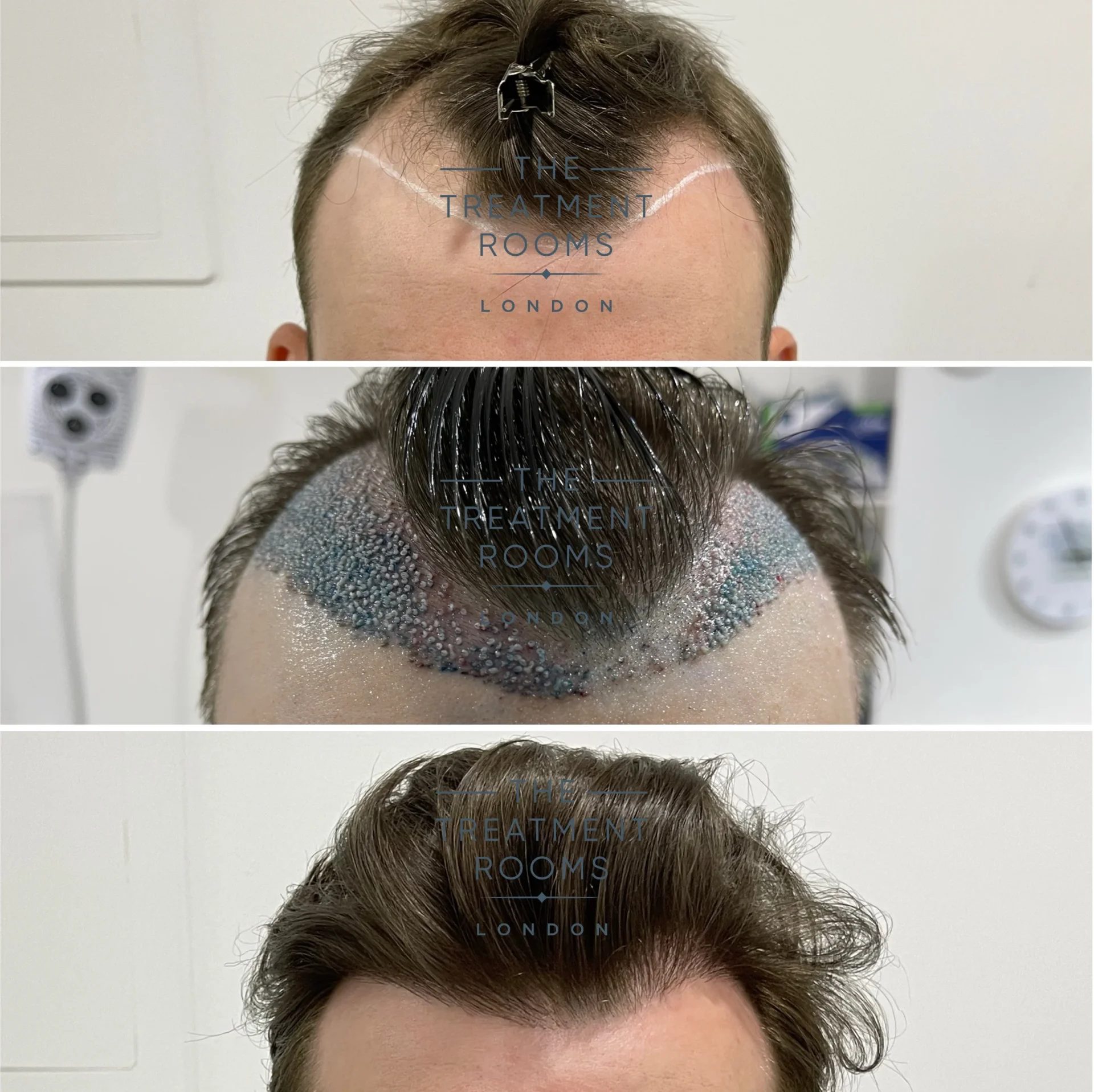
Widow’s peak hair transplant finance
The Treatment Rooms London offers 12 months 0% finance options to patients who are looking to finance the cost of their widow’s peak hair transplant. If you are interested in finding out more about our finance plans for your hair transplant, please let us know.
Is a Hair Transplant for a Woman’s Widow’s Peak a Good Idea?
In women who are looking to change the shape of their widow’s peak and have a rounder-looking hairline, the procedure provides a long-lasting correction to the peaked appearance. It takes around 1 day to complete, followed by a 7–10-day recovery period.
At The Treatment Rooms London, we’re experts in evaluating your hairline and determining the best approach to correcting any issues. Our patients see remarkable results, achieving a more uniform and even hairline.
During the initial personalised consultation, we will advise you on whether an FUE or FUT technique is needed. We always work to minimise scarring and maximise the eventual hair growth. We can also advise on unshaven hair transplant options for women who want extra discretion.
Conclusion
Living with a widow’s peak doesn’t have to be permanent. Whether your hairline is genetic or your hair has receded slightly, we can help. With our corrective treatments, we’ll restore your hairline, creating the even appearance you’re after.
At The Treatment Room London, we offer both FUE and FUT hair transplants for a woman’s widow’s peak. Our surgeons will guide you through the procedure, detailing the best options for your hair. To book a consultation, use our contact form or call 020 8706 0076.
References
- Cleveland Clinic. Hair Loss in Women. Available at: https://my.clevelandclinic.org/health/diseases/16921-hair-loss-in-women
- WebMD. What to Know About Widow’s Peak. Available at: https://www.webmd.com/beauty/what-to-know-about-widows-peak
- Rassman W. Phenotype of normal hairline maturation. Facial Plastic Surgery Clinics. 2013 Aug 1. Available at: https://www.facialplastic.theclinics.com/article/S1064-7406(23)00102-5/abstract
- Kyriakou G, Glentis A, Papanikolaou S. Widow’s peak: a usually overlooked, yet significant morphogenetic trait. JDDG: Journal der Deutschen Dermatologischen Gesellschaft. 2021 Sep;19(9):1271-5. Available at: https://onlinelibrary.wiley.com/doi/abs/10.1111/ddg.14502
- The Treatment Rooms London. FUE vs FUT: Which Hair Transplant Is Best For You? Available at: https://www.treatmentroomslondon.com/hair-transplant-surgery/fue-vs-fut/
Share:
Authored by
Reviewed by
Book a Consultation
Related Blogs
Has Perez Hilton had a hair transplant? All You Need to Know
April 2, 2025
Perez Hilton is a familiar face in the media. He is known for his work as a…
Elton John and His Hair Transplant Journey
March 27, 2025
Sir Elton John has had one of the greatest careers in music. Since his rise to fame…
Steven Whittaker’s Hair Transplant – Before And After
March 25, 2025
As Hibs legend Steven Whittaker makes headlines for taking the Dunfermline player-coach role, many gazes have turned…
Donald Trump’s Hair Transplant Rumours: True Or False?
March 25, 2025
Donald Trump has long been a figure of controversy and conversation, known not only for his political…
Cesc Fàbregas Hair Transplant: Before, After and His New Hairline
March 24, 2025
Hair loss is a common concern among celebrities whose public image often plays a significant role in…
The Effects Of Finasteride On Semen
March 20, 2025
Finasteride is commonly taken to help prevent hair loss in men suffering from male pattern baldness. Before…
A Guide to the Norwood Hamilton Scale: Understanding Hair Loss Stages
March 20, 2025
The Norwood scale (or Hamilton-Norwood scale) is the leading classification system used to measure the extent of…
Male To Female (MTF) HRT Hair Regrowth
March 18, 2025
While hair loss can happen to anyone and negatively impact your wellbeing, it can be incredibly challenging…
Jamie Laing Hair Transplant: Before, After and His New Hairline
March 18, 2025
Taking action to retain his youthful hairline, Jamie Laing decided to get a hair transplant, which changed…









